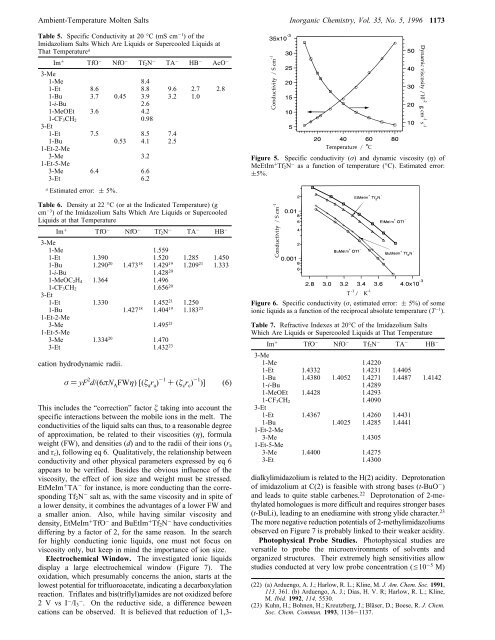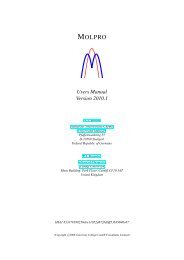<strong>Ambient</strong>-<strong>Temperature</strong> <strong>Molten</strong> Salts Inorganic Chemistry, Vol. 35, No. 5, 1996 1173Table 5. Specific Conductivity at 20 °C (mS cm -1 )oftheImidazolium Salts Which Are Liquids or Supercooled Liquids atThat <strong>Temperature</strong> aIm + TfO - NfO - Tf 2N - TA - HB - AcO -3-Me1-Me 8.41-Et 8.6 8.8 9.6 2.7 2.81-Bu 3.7 0.45 3.9 3.2 1.01-i-Bu 2.61-MeOEt 3.6 4.21-CF 3CH 2 0.983-Et1-Et 7.5 8.5 7.41-Bu 0.53 4.1 2.51-Et-2-Me3-Me 3.21-Et-5-Me3-Me 6.4 6.63-Et 6.2aEstimated error: ( 5%.Table 6. Density at 22 °C (or at the Indicated <strong>Temperature</strong>) (gcm -3 ) of the Imidazolium Salts Which Are Liquids or SupercooledLiquids at that <strong>Temperature</strong>Im + TfO - NfO - Tf 2N - TA - HB -3-Me1-Me 1.5591-Et 1.390 1.520 1.285 1.4501-Bu 1.290 20 1.473 18 1.429 19 1.209 21 1.3331-i-Bu 1.428 201-MeOC 2H 4 1.364 1.4961-CF 3CH 2 1.656 203-Et1-Et 1.330 1.452 21 1.2501-Bu 1.427 18 1.404 19 1.183 231-Et-2-Me3-Me 1.495 211-Et-5-Me3-Me 1.334 20 1.4703-Et 1.432 23cation hydrodynamic radii.σ ) yF 2 d/(6πN A FWη)[(ζ a r a ) -1 +(ζ c r c ) -1 )] (6)This includes the “correction” factor ζ taking into account thespecific interactions between the mobile ions in the melt. Theconductivities of the liquid salts can thus, to a reasonable degreeof approximation, be related to their viscosities (η), formulaweight (FW), and densities (d) and to the radii of their ions (r aand r c ), following eq 6. Qualitatively, the relationship betweenconductivity and other physical parameters expressed by eq 6appears to be verified. Besides the obvious influence of theviscosity, the effect of ion size and weight must be stressed.EtMeIm + TA - for instance, is more conducting than the correspondingTf 2 N - salt as, with the same viscosity and in spite ofa lower density, it combines the advantages of a lower FW anda smaller anion. Also, while having similar viscosity anddensity, EtMeIm + TfO - and BuEtIm + Tf 2 N - have conductivitiesdiffering by a factor of 2, for the same reason. In the searchfor highly conducting ionic liquids, one must not focus onviscosity only, but keep in mind the importance of ion size.Electrochemical Window. The investigated ionic liquidsdisplay a large electrochemical window (Figure 7). Theoxidation, which presumably concerns the anion, starts at thelowest potential for trifluoroacetate, indicating a decarboxylationreaction. Triflates and bis(triflyl)amides are not oxidized before2VvsI - /I - 3 . On the reductive side, a difference beweencations can be observed. It is believed that reduction of 1,3-Figure 5. Specific conductivity (σ) and dynamic viscosity (η) ofMeEtIm + Tf 2N - as a function of temperature (°C). Estimated error:(5%.Figure 6. Specific conductivity (σ, estimated error: ( 5%) of someionic liquids as a function of the reciprocal absolute temperature (T -1 ).Table 7. Refractive Indexes at 20°C of the Imidazolium SaltsWhich Are Liquids or Supercooled Liquids at That <strong>Temperature</strong>Im + TfO - NfO - Tf 2N - TA - HB -3-Me1-Me 1.42201-Et 1.4332 1.4231 1.44051-Bu 1.4380 1.4052 1.4271 1.4487 1.41421-i-Bu 1.42891-MeOEt 1.4428 1.42931-CF 3CH 2 1.40903-Et1-Et 1.4367 1.4260 1.44311-Bu 1.4025 1.4285 1.44411-Et-2-Me3-Me 1.43051-Et-5-Me3-Me 1.4400 1.42753-Et 1.4300dialkylimidazolium is related to the H(2) acidity. Deprotonationof imidazolium at C(2) is feasible with strong bases (t-BuO - )and leads to quite stable carbenes. 22 Deprotonation of 2-methylatedhomologues is more difficult and requires stronger bases(t-BuLi), leading to an enediamine with strong ylide character. 23The more negative reduction potentials of 2-methylimidazoliumsobserved on Figure 7 is probably linked to their weaker acidity.Photophysical Probe Studies. Photophysical studies areversatile to probe the microenvironments of solvents andorganized structures. Their extremely high sensitivities allowstudies conducted at very low probe concentration (e10 -5 M)(22) (a) Arduengo, A. J.; Harlow, R. L.; Kline, M. J. Am. Chem. Soc. 1991,113, 361. (b) Arduengo, A. J.; Dias, H. V. R; Harlow, R. L.; Kline,M. Ibid. 1992, 114, 5530.(23) Kuhn, H.; Bohnen, H.; Kreutzberg, J.; Bläser, D.; Boese, R. J. Chem.Soc. Chem. Commun. 1993, 1136-1137.
1174 Inorganic Chemistry, Vol. 35, No. 5, 1996 Bonhôteetal.Figure 7. Cyclic voltammograms for a stationary Pt electrode (0.78mm 2 ) in various ionic liquids at 23 °C. Sweep rate: 50mV/s. The I - /I 3-couple has a measured potentiel of -0.195 V vs ferrocene/ferroceniumin EtMeIm + Tf 2N - . The reduction current observed in the vicinity of-1.0 V in EtMeIm + TA - appears to result from the reduction ofdissolved H 2O. Effective drying of this salt could not be performedbecause of the low decomposition temperature (see Figure 3).and thus examination of the host environment in nearlyunperturbed state. A large number of fluorescence probes areavailable to determine the polarity, microviscosity, state ofprotonation, etc. Facile observation of room temperaturephosphorescence from solubilized molecules in organized mediasuch as micelles and hosts such as cyclodextrins has led to recentdevelopments of a number of phosphorescent probes. 24 Hereafterwe describe some of our results on fluorescence andphosphorescence probe studies of EtMeIm + Tf 2 N - . The moltensalt is optically transparent at λ g 300 nm, allowing directexcitation of dissolved probe molecules in the UV region.a. Fluorescence Studies Using Pyrenecarboxaldehyde (Py-CHO). Py-CHO has two types of low-lying excited states,(n,π*) and (π,π*), both of which show emission in fluid solutionat room temperature. In nonpolar solvents such as n-hexane,the emission is highly structured and weak arising from the (π,π*) excited state. The upper-lying (n, π*) excited state issolvent-sensitive and can undergo relaxation in polar solvents.When the dielectric constant (ɛ) of the solvent exceeds ca. 10,the emission consists of broad, moderately intense fluorescencearound 400-500 nm coming exclusively from the (n,π*) excitedstate. The emission maximum red-shifts linearly with increasingɛ, atɛ>10; for instance: 1-hexanol (ɛ ) 13.5), 440 nm;n-PrOH (ɛ ) 20.8), 443 nm; and CH 3 OH (ɛ ) 33.0), 450 nm.The fluorescence quantum yield (φ) also increases with ɛ. Inpure methanol, φ ) 0.15 when in methanol-water 1:1, φ )0.69. For this reason, Py-CHO has been used as a probe ofsolvent polarity in various microheterogeneous systems. 25The emission spectrum of Py-CHO in EtMeIm + Tf 2 N - at 20°C shows a maximum at 431 nm, typical from a solvent of verylow ɛ (below 10). The observation of several well-resolvedmaxima in the absorption spectrum of Py-CHO in EtMeIm + Tf 2 N -is also consistent with very low polarity of the medium. Thelowest energy band appears well resolved and intense at 392nm. In polar solvents such as methanol, the absorption spectrumbecomes diffuse with the lowest energy band appearing as aweak shoulder. Py-CHO dissolved in EtMeIm + Tf 2 N - shows(24) (a) Kalyanasundaram K. Photochemistry in Organized and ConstrainedMedia; Ramamurthy V., Ed.; VCH Publishers: New York, 1991;Chapter 2. (b) Kalyanasundaram, K. Photochemistry in MicroheterogeneousSystems; Academic Press; New York, 1987.(25) (a) Kalyanasundaram K.; Thomas, J. K. J. Phys. Chem. 1977, 81,2176-2180. (b) Dederens, J. C.; Oosemans, L. C.; DeSchryver, F.C.; van Dormael, A. Photochem. Photobiol. 1979, 30, 443-447. (c)Kumar, C. V.; Chattopadhayoy, S. K.; Das, P. K. Ibid. 1983, 38, 141-152.Figure 8. Pyrene fluorescence in degassed EtMeIm + Tf 2N - ; excitationwavelength: 345 nm. Trace A: [pyrene] e 10 -5 M. Trace B: broadexcimer emission at [pyrene] ) 5 × 10 -4 M.absorption (and the excitation for the emission) spectral featuresvery similar to those observed in hexane with distinct maximaat 394, 374, 362 nm.By addition of methanol to EtMeIm + Tf 2 N - , the emissionmaximum red-shifts and gains intensity: at 10% (w/w) methanol,the maximum is at 440 nm, corresponding to ɛ ) 13. Themaximum is sensitive enough to show red shift even uponaddition of 1% methanol.b. Fluorescence Probe Studies Using Pyrene. Pyrene isa highly fluorescent aromatic molecule showing interestingproperties that find applications in different domains. Weconsider here two specific cases, viz., the Ham effect on themonomer fluorescence and the dynamics of excimer formation.The monomer fluorescence shows several bands correspondingto different vibrational transitions, some of which are verysolvent-sensitive. While the third band (0-737 cm -1 transition)is medium-insensitive, the 0-0 band (located at ca. 373 nm)gains considerable intensity in polar solvents. The phenomenonhas been widely studied and is known as the “Ham effect”. Theratio of the third to the first band (“the 3/1 ratio”) is a goodqualitative measure of the environmental polarity and findsextensive applications in fluorescence probe studies of microheterogeneoussystems. 26 This ratio is 1.65 in n-hexane anddecreases with increasing solvent “polarity” (0.98 in n-BuOH,0.75 in CH 3 OH and 0.54 in CH 3 CN).Figure 8 shows a representative monomer fluorescencespectrum of pyrene in neat EtMeIm + Tf 2 N - . The measured (3/1) ratio of 0.85 ( 0.05 is close to that of ethanol.The emission decays exponentially with a lifetime of 300 nsin degassed EtMeIm + Tf 2 N - . Quenching of fluorescence bydissolved oxygen is very efficient. In aerated solutions, themeasured lifetime is 145 ns. An estimate for the oxygensolubility in aerated solution can be made using these twomeasured emission lifetimes and a calculated rate constant basedon the Smolouchowski/Stokes-Einstein equations. For aviscosity of 36 cP (Table 4), one obtains k diff ) 1.8 × 10 9M -1 s -1 and this in turn gives the oxygen solubility of ≈2 ×10 -3 M in nondegassed EtMeIm + Tf 2 N - , close to that of organicsolvents like benzene (1.9 mM) or ethanol (2.07 mM). Quenchingstudies in oxygen-purged solutions indicate the saturationsolubilty to be ≈6 × 10 -3 M.A broad, structureless emission (with a maximum around 480nm) attributable to well-known “excimers” can be readilyobserved in EtMeIm + Tf 2 N - solutions with [pyrene] g10 -5 M.(26) (a) Kalyanasundaram K.; Thomas, J. K. J. Am. Chem. Soc. 1977, 99,2039-2044. (b) Nakajima, A.; Spectrochim. Acta 1974, 30A, 360-364. Dong, D. C.; Winnik, M. A., Photochem. Photobiol. 1982, 35,17-21. Lianos P.; Georghiou, S. Ibid. 1979, 30, 355-362.











![Hetero [6+3] Cycloaddition of Fulvenes with N-Alkylidene Glycine ...](https://img.yumpu.com/35423358/1/190x245/hetero-6-3-cycloaddition-of-fulvenes-with-n-alkylidene-glycine-.jpg?quality=85)




